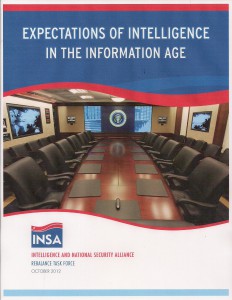
UPDATE: 1 January 2013 from Spanish Dancer:
What is most striking to me, and to a few others I have spoken to recently, is the SECDEF quote early in the paper. If we follow its premise it puts anyone who opposes our projection of power in the cross hairs. It is this doctrinal fluff that we have touted for the last decade that must be tempered, otherwise 97% of the planet is and will our enemy. We will subsequently wrangle our ourselves into skirmishes and actions for nothing more than to save face and uphold flawed doctrine. We must bring to the forefront a sense of rationality about our defense and definition of national security. We must separate these from economic superiority debates and move policy decisions to the ones that truly matter. You have appropriately pointed out these yet again as the prevention of war and humanitarian crisis.
See Also:
UPDATE 5 December 2012: Posted full-text online 2008 Open Source Intelligence (Strategic) 2.0 in support of a larger M4IS2 / OSE dialog and added to existing paragraph on Global Coverage:
For the record, Keith Hall established the budget for the OSA when he was interviewed by Boyd Sutton — $10M a year for each of 150 topics not covered by an IC obsessed on a few hard targets and oblivious to all the rest ($1.5B). Congressman Simmons (then on the Homeland Security Committee) and I added $30M for each of the 50 states to create the bottom up “cop on the beat” and citizen “intelligence minuteman” 119 (auto repeat warning to 5 klik radius) and 114 (text or photo / text with geospatial grid to local fusion center) capabilities and the broader Smart Nation platform for eventually integrating education, intelligence, and research. And then he lost by 80 votes because his staff did not distribute 240 copies of THE SMART NATION ACT: Public Intelligence in the Public Interest, and two newspapers in his district turned against him because in the absence of the books, they had no idea he was a visionary as well as a patriot.
UPDATE 4 December 2012: Short URL created:
http://tinyurl.com/INSA-OSINT
Steele finalized total post and added paragraph:
Put bluntly and directly, if a President were to direct D/OMB to create a Presidential initiative, IOC $125M, FOC $3B, or if a Secretary of Defense were to fund the Open Source Agency (OSA) out of hide, I could, within three to five years, not only provide 90% of the Whole of Government decision-support that is not provided today, but also assure both Whole of Government PPBS/E, and provide the President and Congress with a sufficiency of evidence justifying the reduction of the secret world's budget to below $20B per year, while helping DoD achieve a 450-ship Navy, a long-haul Air Force, and an air-liftable Army with half the flags and half the dollars they have today. This is not rocket science. Intelligence with integrity is the most powerful lever on the planet.
UPDATE 3 December 2012: Added links including DCI Preparing US Intelligence for the Information Age (STIC 93-001, January 1993). INSA is just now getting a partial and terribly flawed view of what the smart people were saying in 1992-1993.
UPDATE 2 December 2012: Richard Wright's comments on paper added at end of post followed by Steele endnote.
Click here to read the press release
Click here to download the one page synopsis of the white paper
Click here to download the white paper
Snap-Shot:
The INSA Rebalance Task Force concluded that although the IC developed world-class capabilities for intelligence-driven tactical operations in the last decade, the sources for developing global situational awareness and providing strategic warning are rapidly changing. The IC will need to develop authorized and appropriate techniques that improve its ability to leverage the growing platforms and vast amounts of information that are now openly available. To successfully leverage openly sourced information, the IC will need to develop capabilities to quickly validate and analyze that information, accurately integrate it with that gleaned from traditional collection sources, and present the resulting knowledge to policy makers addressing national security issues of an urgent and critical nature.
Dr. Stephen Cambone, former Undersecretary of Defense for Intelligence and INSA Rebalance Task Force Chair, said, “The challenge moving forward will be for the IC to enlarge its sphere of collection and the foundation for its analysis beyond the information gained through traditional methods. In the new era of global access to diverse and burgeoning sources of data and information, the Congress will need to authorize appropriate techniques for use by the IC to allow it to extract value and knowledge from open sources.”
The key proposals presented at the conclusion of the white paper are:
- Policy makers should engage the IC to better understand the relative roles of open source and traditional intelligence in meeting the policy makers’ demand for knowledge of national security issues and events.
- The executive and legislative branches should act to ensure that privacy and civil liberty rights impacted by open source collection are protected.
- A coalition of knowledgeable experts should be formed to consider and recommend ways to resolve the practical issues associated with the collection, analysis, validation, integration and dissemination of openly sourced intelligence.
Executive Summary
The U.S. Intelligence Community (IC) is still living largely in the world of traditional secrets. In an era of global access to diverse and rich sources of data and information, the IC must embrace a new understanding of intelligence, knowledge, and rapidly evolving technology in order to sustain its relevance.
• The IC must become a curator of knowledge and information, translating secret and open information into useful knowledge for strategic warning, situational awareness and crisis management.
• In order to meet expectations from national security policy makers, the IC will need to monitor, measure, validate, analyze and distribute information collected in the open source world and across social networks.
• Traditional intelligence activities will retain their importance as the competitive advantage of the IC.
• Policy makers will want this melded knowledge in near real-time, not in days or hours.
• U.S. laws and practices must keep pace with this information revolution in a manner that respects privacy and civil liberties.
• Policy makers are likely to demand reports with knowledgeable insight into the trends that drive groups to form networks opposed to official government policy. Trends of interest include:
oo Shifting demographics
oo Competition for water, energy, food, medicine and other resources
oo Pandemics
oo Cyber threats
oo Global criminal networks
oo Continuing ethnic, sectarian and secular conflict
The white paper concludes with the following proposals:
• Policy makers of the incoming administration must engage the IC to better understand the relative roles of open source and traditional intelligence in meeting policy makers’ needs.
• The executive and legislative branches should propose and/or make policy, regulatory and statutory changes as appropriate and necessary to ensure that privacy and civil liberties are protected.
• A coalition of current and former decision makers and intelligence practitioners, as well as interested policy organizations, should be formed to recommend ways to resolve the practical issues
associated with the collection, analysis, validation, integration and dissemination of openly sourced intelligence.
THE REPORT ITSELF – REVIEW

Click Here to See Personal Page
ROBERT STEELE: The report has no bibliography, no footnotes, and no index. While it bears remarkable similarity to the concepts, doctrine, capabiltiies, and practices I have been calling for since 1988, there are only two people engaged in this report process that are likely to have read some of my work: Joe Mazzafro and Carmen Medina. This may well be an immaculate conception, in which case it is an excellent case study in time lags between agile minds and bureaucratic “no mind” — 20 years. The recommendations almost precisely mirror what Joe Markowitz and Paul Wallner, Tom Pedtke, and I (and a tiny handful of others) were working on in 1992. 20 years! The report is in many ways a perfect counter-foil to my own newest work, “The Craft of Intelligence,” forthcoming in Robert Dover, Michael Goodman, and Claudia Hillebrand (eds.). Routledge Companion to Intelligence Studies (Oxford, UK: Routledge, 31 July 2013), a book I recommend in the strongest possible terms as among the first to really engage 21st Century intelligence challenges and possibilities.
Before my comments, let's start with what the report does not say. It does not say that the US is over-invested in technical collection that does not work as advertised and provides a tiny fraction of what is needed. It does not say that investments in processing have been neglected for fifty years, and that investments in inter-agency and all-source fusion processing have been cursory at best, treasonous at worst. It does not say that our clandestine service is a fraud, our analysts are mostly children, and the security mind-set of the IC is such that effective interaction with the real world, and particularly foreigners who know stuff, is next to impossible. It does not say that still today the National Counterterrorism Center (NCTC) is a very expensive trravesty, with over 80 different databases that have to be individually searched by someone experienced in the arcane search architecture and commands of that specific data base (i.e. a different person for each database), and if they lose their password, it will take days to reset it. And other stuff along those lines.
The following occur to me as I go through the actual 20 page document.
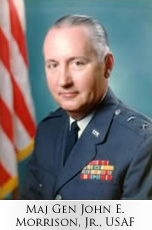 01 This report is 20 years late and out of focus — it is not really focused on all open source information that is mostly human in nature, or even the deep web, but rather on the fad of the day, social media. MajGen John Morrison, USAF (Ret) would keep inviting me to speak to this group in the 1990's, and toward the end I would demur, suggesting that they might be tired of listening to me, and he would say “Robert, you don't understand. They have not been listening in past years. This is the year I hope they will listen!” And so we would try again. I think we gave up on them around 1997.
01 This report is 20 years late and out of focus — it is not really focused on all open source information that is mostly human in nature, or even the deep web, but rather on the fad of the day, social media. MajGen John Morrison, USAF (Ret) would keep inviting me to speak to this group in the 1990's, and toward the end I would demur, suggesting that they might be tired of listening to me, and he would say “Robert, you don't understand. They have not been listening in past years. This is the year I hope they will listen!” And so we would try again. I think we gave up on them around 1997.
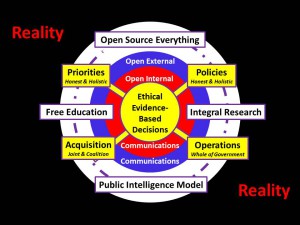
So they are 20 years late and still do not really have a grasp of what it means to have a strategy, to have a strategic analytic model, to have a requirements system, to do warning at three levels (near, mid, long), to do Whole of Government decision-support (at all levels from street and desk to Cabinet, across all mission areas), to take pride in ethical evidence-based decision-support, to actually impact constructively on national priorities, policies, acquisition, and operations — and they are completely lacking on Human Intelligence (HUMINT), multi-anything, and Open Source Everything (OSE).
02 Anyone who thinks that the current national and defense policies toward Asia are a) a strategic pivot and b) policies, does not understand strategy or policy. What we have right now is a massive case of strategic decrepitude, and an incoherent set of policies that are being mocked around the world. The President has just been politely kicked out of Asia, which is refusing the lunatic and predatory Trans-Asian Partnership (you give, we take), and instead going forward with the Regional Comprehensive Economic Partnership that excludes the USA. As with the Community of Latin American and Caribbean States (CELAC) that excludes the USA and Canada, and as with the emerging African, Central Asian and other communities of interest, it is now understood by most that the US Government (not to be confused with the Republic or the public inhabiting America the Beautiful) is toxic — all things being equal, following the USG is a certain heart-break and a probable bankruptcy.
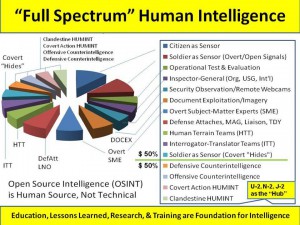
03 This 20-pager fails at three levels.
First: this is not a group that understands Human Intelligence (HUMINT) inclusive of offensive and defensive counter-intelligence (two of the fifteen slices of “full-spectrum HUMINT”).
Second: this is not a group that understands World Brain, EarthGame, Smart Nation, or the eight tribes of information-sharing and sense-making. Certainly this is not a group that has a clue on Epoch B advanced information operations leveraging M4IS2 / OSE.
Third: this is not a group that is truly tuned in to near-real time multi-lingual (183 languages) geospatially-founded machine-speed all source data fusion or processing — they really truly believe in their hearts that “OSINT” is just another technical collection discipline, and processing and sense-making are someone else's problem. In other words, this is a group that has nothing to offer the policy, acquisition, and operations communities, which is ignoring them now anyway (they don't seem to realize that last bit). The focus on “social intelligence” is the indicator of how far off track these people are. With the possible exception of Carmen Medina, I doubt any one of these people knows what “citation analytics” means, or how to leverage it. They are certainly not tuned in to collective intelligence and cognitive surplus — their idea of “social intelligence” is twisted and far removed from the bazaars of humanity outside the USA.
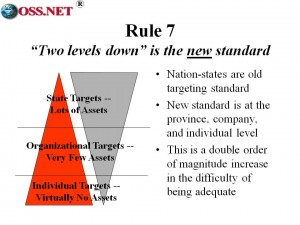
04 “Strategic Warning” and “Demand Pull” are terms of art for “we don't have a clue.” The idea that strategic warning is some kind of connect the dots challenge for high speed high cost technical architectures is a clear sign that the individuals discussing this concept are totally divorced from reality and out of touch with the true craft of intelligence. Strategic Warning — as Michael Herman among others has documented so well — is a long game play, and is almost totally reliant on not just open sources but also Global Goverage (to which I would add Cambone's signal contribution in 2000, going two levels down, to universal neighborhood granularity). “Demand Pull” is an idiot's term for give me more money and I'll figure out something. David Cameron's little dashboard on his cell phone does absolutely nothing at all to help him — it reminds me of NewsEdge, the company that struggled in the 1990's to understand that humans would not value having to read a headline every 15 seconds. I already do strategic warning (I tell the truth), and I already do Demand Pull in a way this group cannot compute, precisely as I described it in Canada in 1994, by abandoning the linear paradigm and embracing the diamond paradigm. Just as when I soundly exposed the IC's debility with a few phone calls in the 1995 Aspin-Brown challenge match on Burundi, I know who knows and I can put a policy maker or acquisition manager or operator in touch with the person who knows in their head, who can create instant tailored answers that did not exist in analog or digital form before. Even if an IC analyst knows what I know, with the present deeply ingrained mind-sets of the aging security force, the IC will remain dysfunctional no matter how smart any one analyst might be.
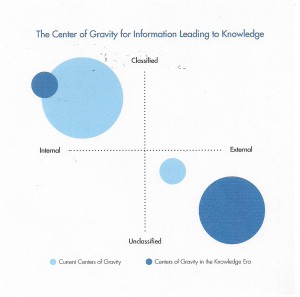
05 “The sources, methods, tools, and products available in the private sector rival and, in many instances, surpass those of the IC.” I am reminded of John Perry Barlow's visit to CIA in the aftermath of their encountering him in 1992 at my first conference, and his famous 2002 description of CIA, in Forbes, as being the last vestige of the Soviet gulag and Soviet-era office style, equipment, and culture. There you have it, but the good news is that most corporations, non-profits, academics, civil society, etcetera, they don't have a clue either. Intelligence is not a profession today, it is a scam, and both practitioners and policy makers share the blame for letting secret intelligence get away with vaporware for the past 50 years. As I lectured NSA in Las Vegas in 2002, we are long overdue for focusing on the I in IT (and yes, Peter Drucker said this first in 1998, but the IC would not listen to him either).
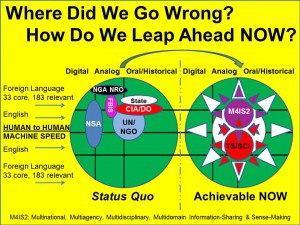
06 I enjoy their one graphic above, as it reminds me of my 1990's version — my latest from 2009 is here to the right — and makes as much sense. The problem the IC has is that it has refused to be serious about OSINT (or M4IS2) for 20 years, and at the same time been oblivious to the fact that when fiscal cliff time comes, those who do not work do not eat — the IC has not earned its way, and it is too late for most of those serving in leadership positions (really more like very senior administrative clerkships) to do anything other than plan for their retirement. They literally do not know what they need to know to be effective. It saddens me to reflect on how much I and Andy Shepard and a few otherss knew in 1992 — 20 years ago — and we did not stop learning. Today I know vastly more than any IC leader [or wanna-be] about the viable options, but absent a President or Secretary of Defense that actually wants to use intelligence to dramatically lower the cost of Whole of Governance while dramatically increasing benefits to the public, I see no way forward within the USG.
[NB: I held Full Scope for 30 years (1976-2006), and now have an OPM SSBI completed 12 March 2012. I am looking for just one IC or DoD senior with an open mind…I know precisely what is needed and how to do it and I have the only little black book of names, not just in NCA but world-wide, that is actually worth something to anyone who would like to build an IC that cannot be ignored or have its budget sacrificed to the fiscal cliff gods. Not only could I create an Open Source Agency overnight, but with USG access and validation, Sir Richard Branson and The Virgin Truth could be a public diplomacy triumph — a game changer. But I would be happy in any job, my SF-50 documents my departure as a Excepted Permanent Veteran at GS (previously GM) 14 step 5, and my SF-52 shows me recommended for rehire and promotion.]
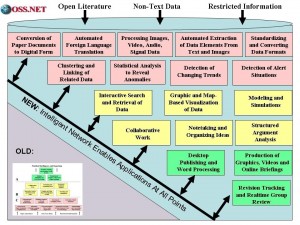
Click on Image to Enlarge
The US IC was told in 1985-1988 exactly what it needed to do in order to enter the 21st Century with some semblance of capacity, and each of the seniors then serving refused to be wise. Diane Webb and Dennis McCormick under Gordon Oehler were ignored and pushed out, or we would have CATALYST (Computer Aided Tools for the Analysis of S&T) today. Andy Shepard made it all the way to ADDNI/AP and finally retired without ever seeing his promising 1992 vision implemented. Tim Hendricks with GRANDVIEW at the National Ground Intelligence Center (NGIC) was starved out at the same time that the Army started falsifying databases to inflate the threat and justify heavier systems (never mind little things like bridge loading data). Later, a second generation innovator, Carol Dumaine sidelined at Energy and is now in a nunnery, while her brilliant idea, Global Futures Partnership was starved to death and eventually drop-kicked over to State where it appears to be buried. The list is long.
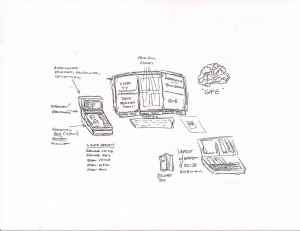
I particularly want to mention JNIDS IV. In 1989 the Marine Corps proposal, to build an all-source fusion work station, won. As I learned years later (too late to get the Commandant of the Marine Corps wound up), the Admiral nominally in charge of JNIDS overturned that win with the words “We are a Navy shop, we will do a Navy problem.” That is precisely the kind of corruption — a complete lack of professional integrity — that is pervasive in our Armed Forces, in our secret intelligence world, and across the US Government. ENOUGH!
Truth and integrity are back in style. Get with the program!
07 As I finish the conclusion, I am confirmed in my view that this paper is written for the purpose of justifying a whole new suite of technical collection investments — and some processing investments, but heaven forbid they actually coordinate with OMB about common solutions for producers and consumers of intelligence — or that they contemplate for one instant the M4IS2 / OSE concepts that can be implemented in tandem or in isolation. Their final headline:
The IC will become ineffective if it fails to assimilate these new and dynamic information technologies, capabilities, processes, and means of conveying
knowledge to policy makers.
Duh. This is not a serious effort, and if this is the best that INSA and the contributors — less Cambone, Medina, and Mazzafro can do — then they need to stay retired, they are still part of the problem.
As I go over the paper a second time, four big things keep coming back to me, all of them well-known to those of us that have labored for twenty years to get people to listen to common sense in the public interest:
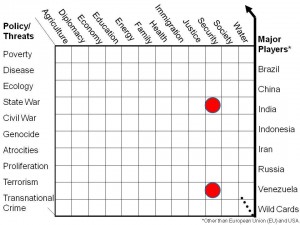
01 Strategic Analytic Model. These people have no idea that the ten high-level threats to humanity have already been identified and prioritized, and that the US Government is in willful ignorance of seven of the ten. At the same time there is no sense of how to address the cross-cutting policies, the true costs of goods and services, the whole system model, and so on. Or even – shudder — true cost economics across all Whole of Government mission areas.
02 Global Coverage. Boyd Sutton knows more about Global Coverage than this entire group. It may be time to bring him back. For the record, Keith Hall established the budget for the OSA when he was interviewed by Boyd Sutton — $10M a year for each of 150 topics not covered by an IC obsessed on a few hard targets and oblivious to all the rest ($1.5B). Congressman Simmons (then on the Homeland Security Committee) and I added $30M for each of the 50 states to create the bottom up “cop on the beat” and citizen “intelligence minuteman” 119 (auto repeat warning to 5 klik radius) and 114 (text or photo / text with geospatial grid to local fusion center) capabilities and the broader Smart Nation platform for eventually integrating education, intelligence, and research. And then he lost by 80 votes because his staff did not distribute 240 copies of THE SMART NATION ACT: Public Intelligence in the Public Interest, and two newspapers in his district turned against him because in the absence of the books, they had no idea he was a visionary as well as a patriot.
03 M4IS2. Joe and Carmen certainly understand my focus on the eight tribes of information-sharing and sense-making, within which government is the least important, generally the beneficiary rather than the benefactor. For this report to not have an semblance of understanding of what it takes to create a Smart Nation, is an indictment of INSA and its corporate membership.
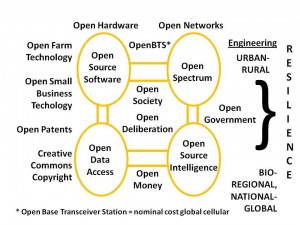
04 OSE. Most in the IC are as ignorant of OSE as they still are of semantic processing, open hypertextdocument system and other innovations that are inevitable as the world by-passes the US Government — as John Perry Barlow said so famously, the Internet interprets censorship as an outage, and routes around it. Well, in a world of distributed intelligence, the Internet interprets stupidity as an outage, and routes around it.
I will be blunt, as is my wont when not serving another master [if someone were to hire me — I am not interested in corporate, only government — I would close down my public persona]: this report lacks intelligence and it lacks integrity. It is a vanilla justification for technical systems we do not need and cannot afford. It is devoid of understanding with respect to HUMINT, strategic analytic modeling, global coverage, all-source processing, M4IS2, and OSE. It certainly does not anything to enhance decision support to tactical combatants or policy makers and acquisition managers. I am glad I read it. These many years in the wilderness (20, actually), I have on occasion doubted my value. This report is as much validation as I am likely to get in the near term. For that I am thankful. St.
See Also:
Articles & Chapters Directory (List)
Briefings & Lectures Directory (List)
Books on Intelligence & Information Operations by Robert David STEELE Vivas et al
Photographs: Robert David STEELE Vivas at 60
Who’s Who in Collective Intelligence: Robert David STEELE Vivas
Worth a Look: Book Review Lists (Negative)
Worth a Look: Book Review Lists (Positive)
Worth a Look: Book Reviews on Intelligence (Most)
UPDATE of 2 December 2012

RICHARD WRIGHT:
Robert,
I read the entire INSA paper with considerable interest. It attempts to balance between the obvious need to take open source intelligence seriously in light of the so-called “Global Network*” and the need to protect the traditional institutional producers of secret intelligence. What is really needed is a recognition that the time has come for the U.S Government (I use the term advisedly) to recognize that your ideas on OSINT are absolutely relevant for the 21st Century.
As for your critique of this paper, you are absolutely dead on. With folks like General Hayden (USAF ret.) signing off on it you can bet it was designed precisely not to make waves. I am sure Charlie Allen was sent off to some make work research project to keep him out of everyone’s hair. The basic problem is that INSA is unwilling to commit to the concept of an independent OSINT Agency because it would make it clear that CIA has not done the job it was created for by the 1947 National Security Act: namely to collate and organize all source information to provide strategic and tactical warning intelligence of another Pearl Harbor and strategic intelligence to decision makers. This last capability disappeared with the dissolution of the CIA’s Office of National Estimates (ONE) by President Nixon. INSA is trying to give the illusion of bold proposals while still protecting the status quo. Still at least your ideas OSINT are gaining wider recognition, even if you as the real expert in OSINT are ignored.
* The Global Network is a rubric for an aggregate of independently owned and operated, but inter-connected and inter-operative telecommunication (carrier) networks. These networks incorporate both domestic and international carriers each of which consists of transmission lines (largely fiber optic or copper cable and satellite spot beams) coupled with relays, switching centers, earth stations, and various other sub-components. The content carried on these networks is obtained from public and private content providers. The public content providers include Internet Service Providers (ISPs) and Public Service Telephone Networks (PSTN). The private content providers include such entities as SWIFT and SITA. Inter-operability between the carrier networks and between the carriers and content providers is made possible by common sets of standards and procedures as established by international agreements through such agencies as the CCITT and ITU.
The INSA Paper is I hope only the first step towards real intelligence reform.
Richard

Click Here to See Personal Page
ROBERT STEELE: Richard's deep knowledge, with decades at both NSA and DIA, is a most helpful balance to my own. We are in agreement on the INSA paper, but I would stress that I am less satisfied with the INSA paper's cursory acknowledgement of “full spectrum” OSINT (they do not have a clue), that is focused exclusively on keeping the money moving toward corporate vapor-ware ostensibly capable of processing the entire Internet and particularly social media sites used by the one billion rich. The US secret intelligence mandarins (really more like super-empowered clerks) are not really devoted to the public interest, have not figured out that M4IS2 / OSE and the five billion poor are the center of gravity for future stabilization & reconstruction, and therefore they all continue doing the wrong things righter, certain that they will retire before anyone catches on to their ignorance, and equally certain that there are no retirement jobs for them in the world of OSINT, only in the world of make-believe, the world of corporate vapor-ware where no one is held accountable for failure. I am an intelligence professional and I take the craft of intelligence seriously. We have too many bureaucrats and clerk-leaders at the top of the intelligence hierarchy, and too many middle managers whose last original thought was twenty years ago (unlike the private sector, middle management is alive and well within the US Government, and particularly in the secret world where no manager is held accountable for outputs, decision-support, only for inputs — dollars spent, no questions asked).
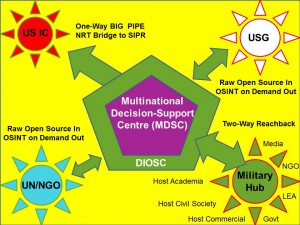
I have already reached the conclusion that in addition to the Open Source Agency [that would include General Tony Zinni, USMC (Ret) National Planning and Monitoring Center (NMPC) as a Whole of Government capability that works closely with the Office of Management and Budget (OMB) and all elements of the government, to do ethical evidence-based Planning, Programming, Budgeting, and Execution (PPBS/E); and my own long-recommended Multinational Decision-Support Centre (MDSC) [the hub for military-operated national centers in every country that signs the new Global Information-Sharing and Sense-Making Treaty, with the military organizing their countries other seven tribes for give and take] we also need to create a new national full-spectrum HUMINT capability that is virtually distributed, does not use official cover in any way whatsoever, is often multinationally-organized, region by region, and practices risk-based need to know security, avoiding the severe deficiencies of the current “system high US citizens only” HUMINT networks. Neither CIA nor DIA — and even less so SOCOM — are capable of executing that vision absent draconian mandated turn-over. The OSA, with an SCI/SAP appendage,is in my view the logical starting point, since 90% of the HUMINT is open, not secret.
Put bluntly and directly, if a President were to direct D/OMB to create a Presidential initiative, IOC $125M, FOC $3B, or if a Secretary of Defense were to fund the Open Source Agency (OSA) out of hide, I could, within three to five years, not only provide 90% of the Whole of Government decision-support that is not provided today, but also assure both Whole of Government PPBS/E, and provide the President and Congress with a sufficiency of evidence justifying the reduction of the secret world's budget to below $20B per year, while helping DoD achieve a 450-ship Navy, a long-haul Air Force, and an air-liftable Army with half the flags and half the dollars they have today. This is not rocket science. Intelligence with integrity is the most powerful lever on the planet.
There is also a very important role for the United Nations and perhaps NATO/PfP, but as things now stand I do not see the Cabinet level intelligence with integrity needed to allow me — or someone I advise — to put all these pieces together in a USG context favorable to the USA.
As I have noted elsewhere, I am far beyond OSINT. HUMINT is the center of gravity, OSINT is part of HUMINT, and M4IS2/OSE are the foundation for both multinational HUMINT/OSINT — 80% — and unilateral HUMINT/OSINT — 20%. HUMINT and OSINT — designed and executed with integrity — are the foundation for 21st Century intelligence. St.
See Also:
2012 Robert Steele: Practical Reflections on UN Intelligence [Document] + UN RECAP 3.3
2010: Human Intelligence (HUMINT) Trilogy Updated
2009 DoD OSINT Leadership and Staff Briefings
Tony Zinni, The Battle for Peace: A Frontline Vision of America’s Power and Purpose (Palgrave Macmillan, 2007)
DCI Preparing US Intelligence for the Information Age (STIC 93-001, January 1993)



